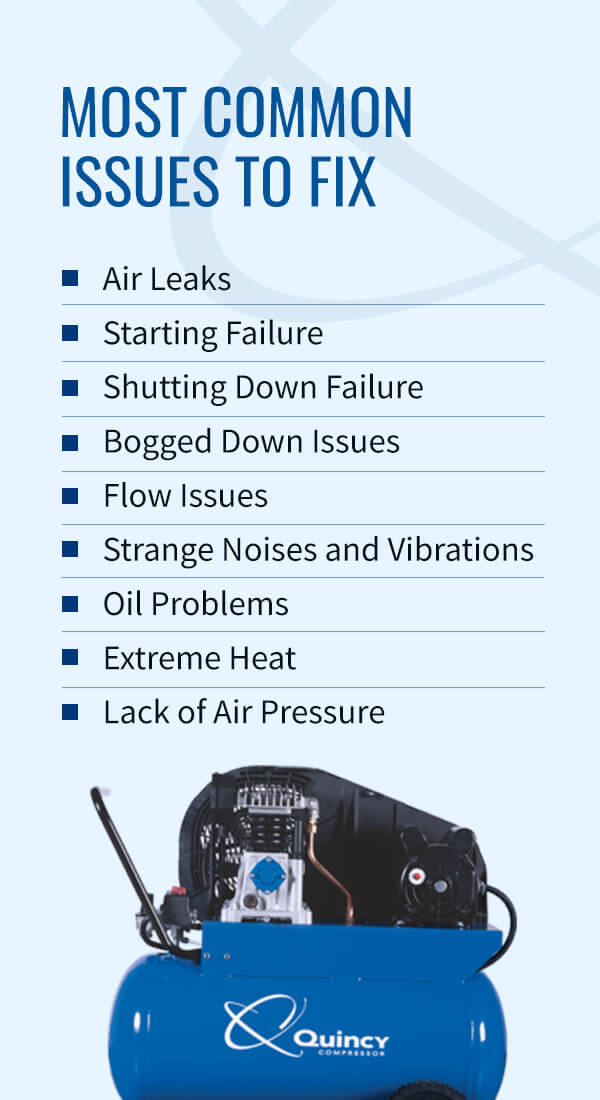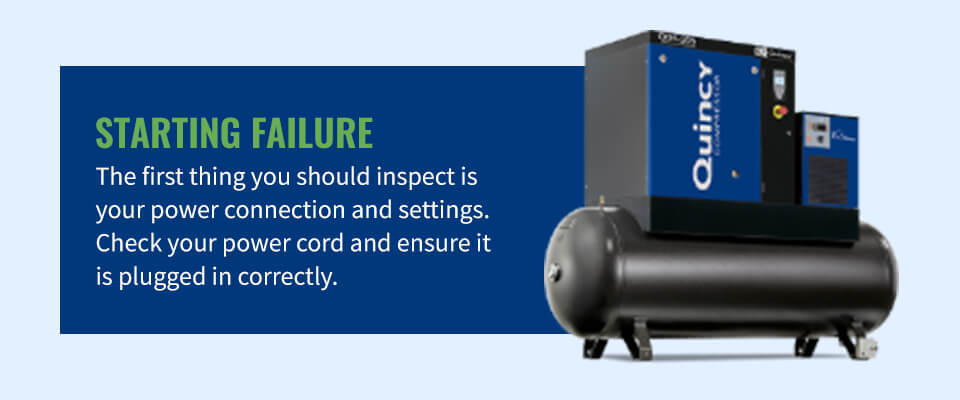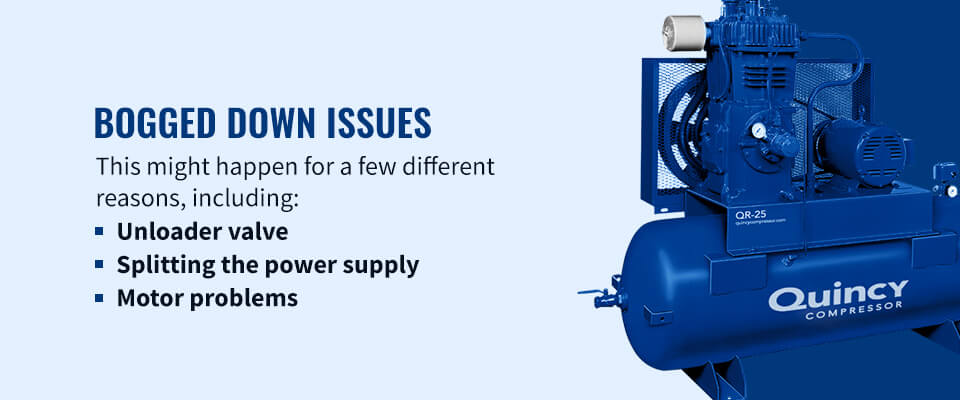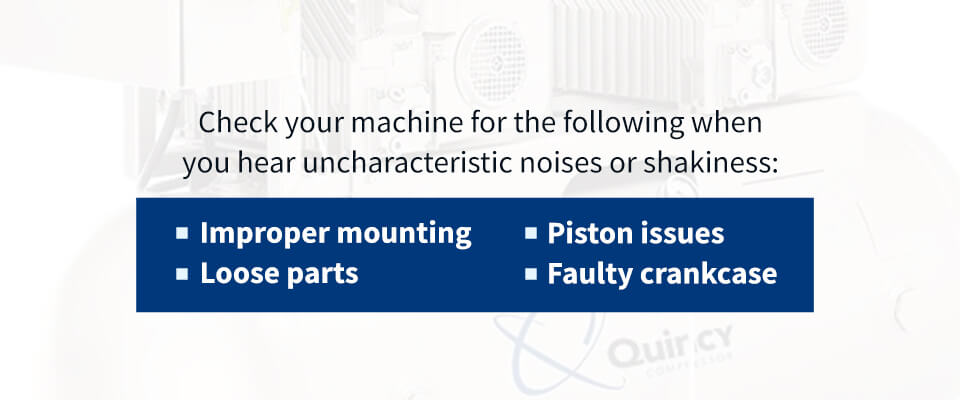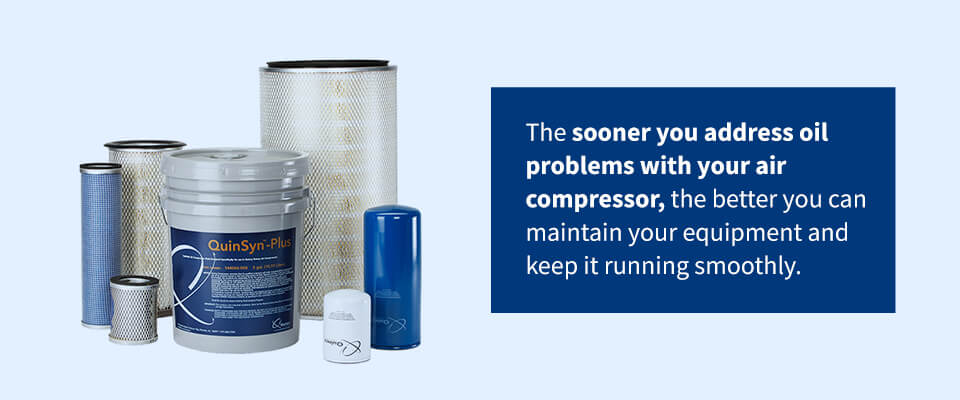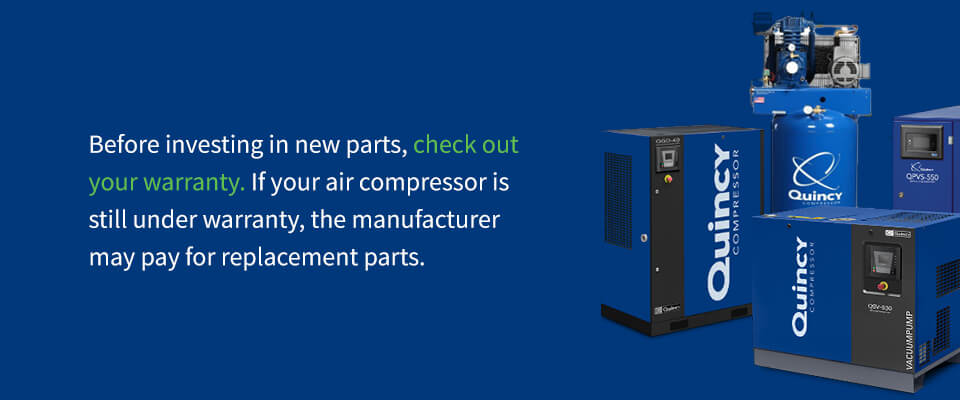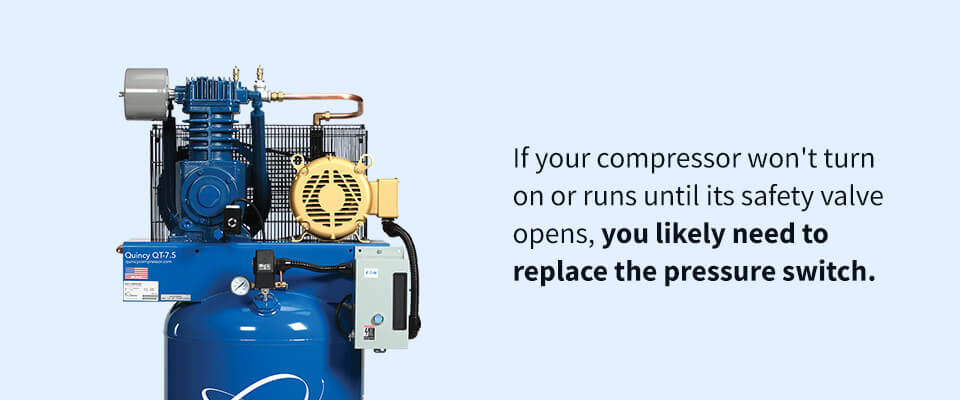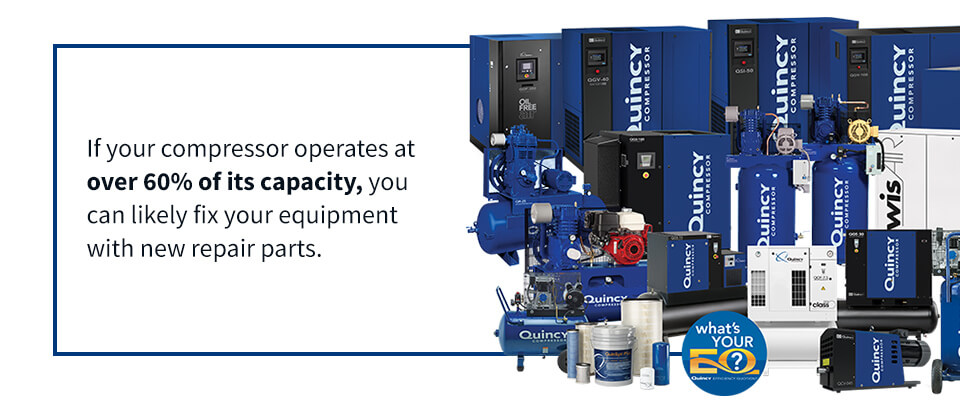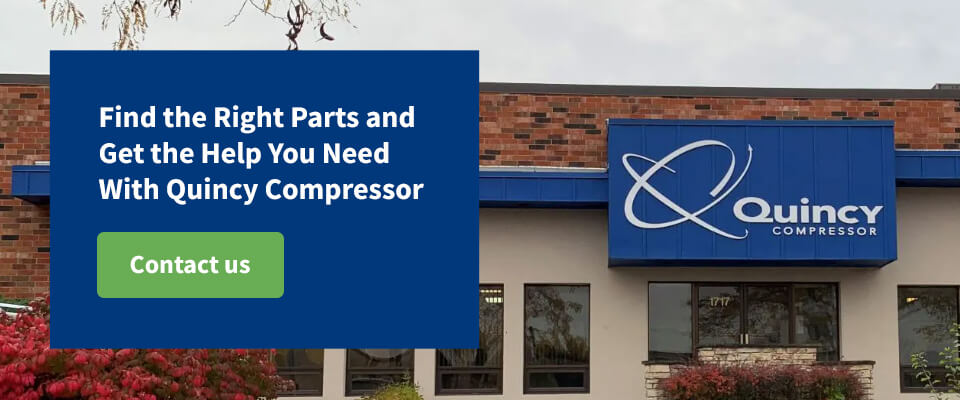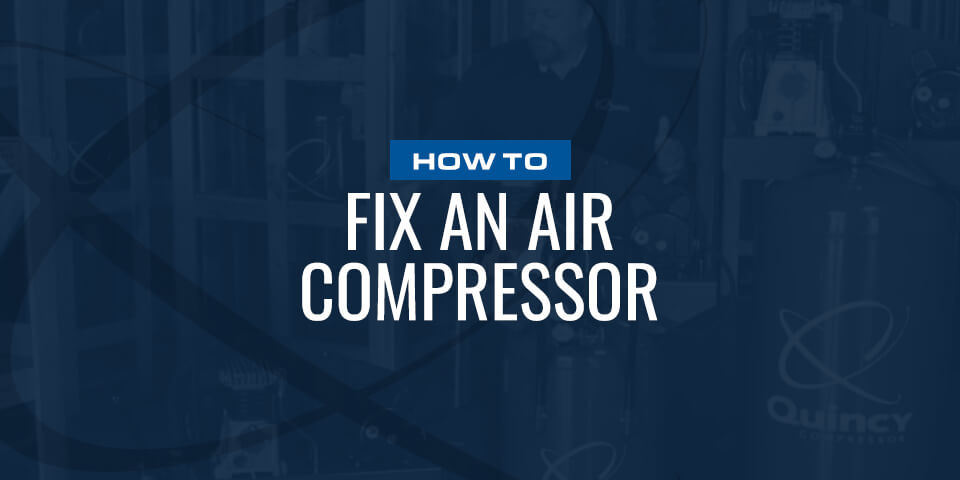
You need your air compressor to be ready to work when you are. By familiarizing yourself with common issues with this type of equipment, you can learn how to address minor repairs before they become costly.
From identifying the source of an air leak to replacing a pressure switch, this article covers many different maintenance needs that you should understand to keep your equipment operating at its best.
Learn how to fix an air compressor and some situations where replacing your equipment is a better option than repairing it.
Most Common Issues to Fix
Explore some common problems with air compressors, and learn how to identify and address them.
Air Leaks
Air leaks are one of the most common problems associated with air compressors. You should actively pay attention to weak spots and potential holes in your air hoses and valves.
Any time you notice the gauge indicating lower pressure after deactivating the air compressor when the tank is full, you are likely dealing with an air leak.
A few methods to help you effectively identify the leak include:
- Feel for the escaping air: Use your hand and hover over your compressor’s hoses. You can locate the leak by feeling around for the stream of air.
- Listen for hissing: If you listen closely, you may be able to hear the hiss of the air escaping to identify where the hole is.
- Use liquid soap: You can apply a thin layer of liquid soap on your air compressor’s connections, including the equipment’s power switch and couplers. Any holes will bubble as the air escapes.
Luckily, repairing air leaks is relatively easy compared to other repairs. You can easily patch holes with a seal.
Air leaks can also happen when a tank check valve is not completely closed. Anytime you notice the pressure gauge dropping when you’ve turned off the tank, take a closer look at the valve’s condition. You may need to clean or replace it to fix the leak.
Starting Failure
Starting failure is another common issue associated with air compressors. Equipment not powering up could be due to a few different causes, so you’ll want to examine every potential issue to find the root of the problem and adequately address it.
The first thing you should inspect is your power connection and settings. Check your power cord and ensure it is plugged in correctly. Look at your power switch to see if it is on. Once you’ve checked these two things to ensure neither is responsible for the problem, you can explore other possible causes.
If the power connection and settings are all good, your compressor is likely failing to start because it lacks sufficient air pressure compared to cut-in pressure.
A compressor’s cut-in pressure should be lower than its cut-out pressure. If it is not, the machine will start and stop continuously. To fix the problem, adjust your pressure set points accordingly.
Your air compressor could also fail to start because of a lack of oil. Follow a regular maintenance schedule to change your equipment’s fluids and avoid an empty oil compartment.
Shutting Down Failure
Another common problem with air compressors is failing to shut down. Your equipment should stop running when the tank pressure reaches the cut-out point. If your equipment continues operating after turning it off, it could be due to a faulty pressure release valve or power switch.
A faulty pressure release valve could keep your motor from shutting down. In this case, the valve is not releasing the pressure effectively, and the compressor is too pressurized to turn off. If you do not address this issue, it can cause serious damage to your machine.
When your air compressor does not shut down, the best thing to do is to cut off the power and replace the valve promptly.
You could also experience a shutdown failure because of a defective power switch. The broken switch could impact the signal for your internal controls, and you may need to swap it out with a replacement.
Bogged Down Issues
When an air compressor bogs down, it can be very frustrating. This might happen for a few different reasons, including:
- Unloader valve: Your problem may be due to the air compressor’s unloader valve. You can test this by opening the tank drain and allowing the air to escape to simulate its function and remove water. To test the valve, close the drain and power up the compressor. Replace the valve if the compressor runs up to cut-out pressure.
- Splitting the power supply: Another culprit could be your power supply. Using an extension cord that’s too small or plugging too many appliances into the same circuit can bog down your compressor.
- Motor problems: If your machine runs for a short time and then loses power, it could be due to issues with the compressor’s motor.
If you correct these problems and your air compressor continues to bog down, your equipment’s capacity may not be suitable for your application.
Flow Issues
Identifying pressure and flow problems with your air compressor can be more challenging than other common issues. The machine may appear to be working properly at first glance. However, if you notice your equipment is reaching too much or too little pressure, your compressor may need some attention. To identify flow issues, inspect the following components:
- Gasket
- Piston seal
- Intake valve
- Pressure valve
- Tank check valve
If you notice any of these parts are worn or damaged, you may need to replace them to correct the flow issues. However, if these components are in good condition, your problems could be due to other factors, such as:
- The pressure gauge setting is too low.
- An ill-fitting coupler is blocking your compressor’s airflow.
- An obstructed intake filter is causing the compressor to take longer to build pressure, straining your machine.
Strange Noises and Vibrations
You are likely familiar with the typical sounds and vibrations associated with your air compressor. If you notice the machine is louder than usual when you power it up or it is reverberating more than normal, explore the possible causes.
Check your machine for the following when you hear uncharacteristic noises or shakiness:
- Improper mounting: If your equipment is improperly mounted, your compressor can rattle when in use. You may need to refasten boots or add vibration pads to correct mounting errors.
- Loose parts: Inspect all of the bolts and belts on your compressor. If any are misaligned or loose, correct and tighten them promptly.
- Piston issues: Pistons contacting the valve plate can be noisy and unpleasant. Adjust these as needed to avoid unnecessary sounds.
- Faulty crankcase: Take a look at your crankcase. If it doesn’t have enough oil, add more or replace it. If it has defects, you may need new bearings.
Oil Problems
It’s best to take problems relating to your air compressor’s oil very seriously. Ignoring them can cause significant damage, and you may have to replace your machine entirely. Expired fluids and dispersion are two of the most common oil issues.
If you notice your machine’s oil is expiring too quickly, you should check for the following:
- Leaks
- Obstructions
- Worn piston rings
- Improper viscosity
Dispersed oil can cause cracking and swelling in your compressor’s seals. To get to the root of the problem, closely inspect your compressor. Look for the following causes of dispersed oil:
- Excessive oil in the tank
- Incorrect oil viscosity
- Inverted piston rings
- Expired piston rings
- Air intake restriction
Tending to oil issues as soon as possible is critical to minimizing the damage they can cause to your machine. The sooner you address oil problems with your air compressor, the better you can maintain your equipment and keep it running smoothly.
Extreme Heat
Another common issue with air compressors is extreme temperatures. Without adequate airflow, your machine can overheat and become dangerous.
If your machine produces too much heat, it can be a safety hazard and could damage the compressor, its surroundings or your workers.
Here are some of the typical reasons for overheating:
- Dirt accumulation: Dirt and debris collecting inside your air compressor can impact airflow and lead to hot temperatures.
- Poor ventilation: If you keep your machine in a hot location or somewhere with poor ventilation, your equipment can overheat.
- Limited air intake: When the air intake on your compressor is obstructed or not ventilated properly, the machine has to work extra hard and can generate overly hot air.
- Wear: Your equipment may produce too much heat if your valves and head gasket are overly worn.
Lack of Air Pressure
Lack of air pressure is a significant issue with any compressor. When your equipment doesn’t build up enough pressure, you should inspect it thoroughly. You can conduct a pump test by emptying the air tank and timing how long it takes for your machine to reach a certain pressure starting from zero. Your compressor should reach the desired pressure in a specific time frame outlined by the manufacturer.
If your machine is not producing the pressure you need, there could be a few different factors to blame, including:
- Dirty filters: Dirt and debris build-up on your air inlet filters can negatively impact air pressure.
- Leaks: The most obvious culprit of low pressure is a leak in your air compressor’s hoses or valves.
- Worn or misaligned rings and valves: As your valves and pump rings wear down, they create less effective seals and allow air to escape.
- Belt condition: Belt malfunctions often cause low air pressure, and belts must be perfectly placed for optimal operation.
- Gasket: The gasket between the high- and low-pressure compartments in your compressor may cause problems with your air intake pump and lead to inadequate air pressure.
Tools and Materials Needed to Repair Air Compressors
The following are common tools needed to replace and repair parts on your air compressor:
- Needle nose pliers
- Adjustable wrench
- Socket wrench
- Wire cutters
- Screwdriver
- Screws
- Bolts
The exact tools you’ll need will depend on your specific air compressor’s model and manufacturer. You’ll also need high-quality replacement parts compatible with your existing compressor.
Before investing in new parts, check out your warranty. If your air compressor is still under warranty, the manufacturer may pay for replacement parts. You may also need to turn to a professional for help to ensure your machine’s repairs are effective and secure.
Replacing Parts of Your Air Compressor
Knowing how to replace parts on your air compressor is a handy skill for all owners and operators. Explore the different steps to swap out worn or damaged parts for new ones.
Replacing the Check Valve
Replacing the check valve on your air compressor involves a relatively simple process.
Follow these easy steps to install a new check valve on your machine:
- Open the drain on your air tank and empty all of the air.
- Remove the hose clamp with wire cutters and remove the hose from the check valve.
- Use a socket wrench to remove the old check valve from your air tank.
- Install your new valve by tightly screwing it onto your tank.
- Slip a replacement hose clamp over the hose and attach it to the check valve before tightening it.
- Secure the clamp by using a pair of pliers to squeeze the clamp’s tabs together.
Replacing the Regulator
If your regulator’s internal components are worn and starting to fail, you may need a replacement. Use these steps to install a new one on your air compressor:
- Open the drain valve on your air tank and allow all the air to empty before getting started. You can close the drain valve once all the pressure is removed.
- Using an adjustable wrench, loosen and remove the coupler.
- Once you’ve removed the coupler, unscrew the nipple between the regulator and the pressure switch with your adjustable wrench.
- Next, you’ll remove the nipple from the old regulator.
- Reattach the nipple to your replacement regulator and tighten it.
- Take your new regulator and attach the pressure switch on your air compressor to it.
- Reinstall your coupler, and you are done.
Replacing the Pressure Switch
If your compressor won’t turn on or runs until its safety valve opens, you likely need to replace the pressure switch. To do so, follow these easy steps:
- Depressurize your air tank by opening the drain valve and allowing all the air to escape before you begin.
- If there is a manifold cover on your air compressor, you will need to unscrew it and remove it.
- Remove any screws that attach the pump to your air tank. Lift the pump and set it aside.
- Unscrew and remove half of the pump cover. If your air compressor has a handle attached to the pump cover, you may need to remove that as well.
- Use needle nose pliers or a screwdriver to disconnect and remove connections.
- Pull the pump out of its cover and place it to the side.
- Use wire cutters to remove the clamp on the hose attached to your pressure switch. Remove the hose.
- Remove the red wire connecting the pressure switch to the on and off switch.
- Unscrew the pressure switch bracket and remove it from the compressor.
- Insert the pressure switch hose through the hole and secure it with a screw. Reinstall the red wire to the on and off switch.
- Place a clamp on your hose before reattaching it to the manifold nipple. Close the clamp with pliers.
- Resecure connections and put the pump back into its cover.
- Reattach the other half of the cover and your handle with screws.
- Screw your pump and tank back together and reattach your manifold cover.
Replacing the Valve Plate
A worn valve plate can prevent your compressor from producing adequate air pressure. Check out these steps for replacing your existing valve plate:
- Drain all of the air out of your tank.
- Use an adjustable wrench to loosen and remove the feed tube that connects your cylinder head to your air tank.
- Remove the cylinder head with a socket wrench.
- Remove the old valve plate.
- Install the new valve plate on the cylinder.
- Resecure your cylinder head with bolts.
- Reinstall the feed tube to finish.
When to Repair vs. When to Replace
When your equipment isn’t working correctly, you may wonder whether you should buy replacement air compressor parts or replace your machine entirely.
If your air compressor fits the following characteristics, you can likely opt for repair parts rather than replacing your machine:
- Age: Consider how old your machine is. If it is less than 10 years old, you can likely turn to a professional for repairs instead of investing in a new model.
- Recent repairs: If your equipment has not had costly maintenance within the last year, you may financially benefit from buying new parts and tuning up your current air compressor.
- Operating conditions: You want your machine to work quickly and be energy efficient. If your compressor operates at over 60% of its capacity, you can likely fix your equipment with new repair parts.
- Availability of parts: Repairs are easy when your air compressor’s replacement parts are readily available for all your maintenance needs.
The following are circumstances when it may be advantageous to replace your air compressor with a new model instead of using replacement parts for a repair:
- Age: If you have been running your air compressor for more than 10 years, your equipment could be very worn and inefficient. You are likely ready for a newer model.
- Recent repairs: Repeatedly paying for repairs can add up in the long run. If you have dealt with recurring breakdowns over the last year, you may want to invest in a new machine.
- Operating conditions: Look at your current equipment’s energy efficiency and operating conditions. You may want to replace your compressor if it runs at less than 60% of its capacity.
- Availability of replacement parts: If you experience a breakdown with your machine and have difficulty finding replacement parts for your system components, replacing your air compressor entirely may be a better option.
Find the Right Parts and Get the Help You Need With Quincy Compressor
When you need high-quality air compressor replacement parts for your machine, turn to Quincy Compressor. We have the services and parts you need to keep your equipment performing at its best.
Our team of knowledgeable air experts is here to help you maintain your air compressor. We want to help you extend its life by easily making necessary repairs and replacements. Count on us to keep your operations up and running.
Are you interested in learning more about around-the-clock assistance from our service technicians? Explore services from Quincy Compressor, or contact us today!


